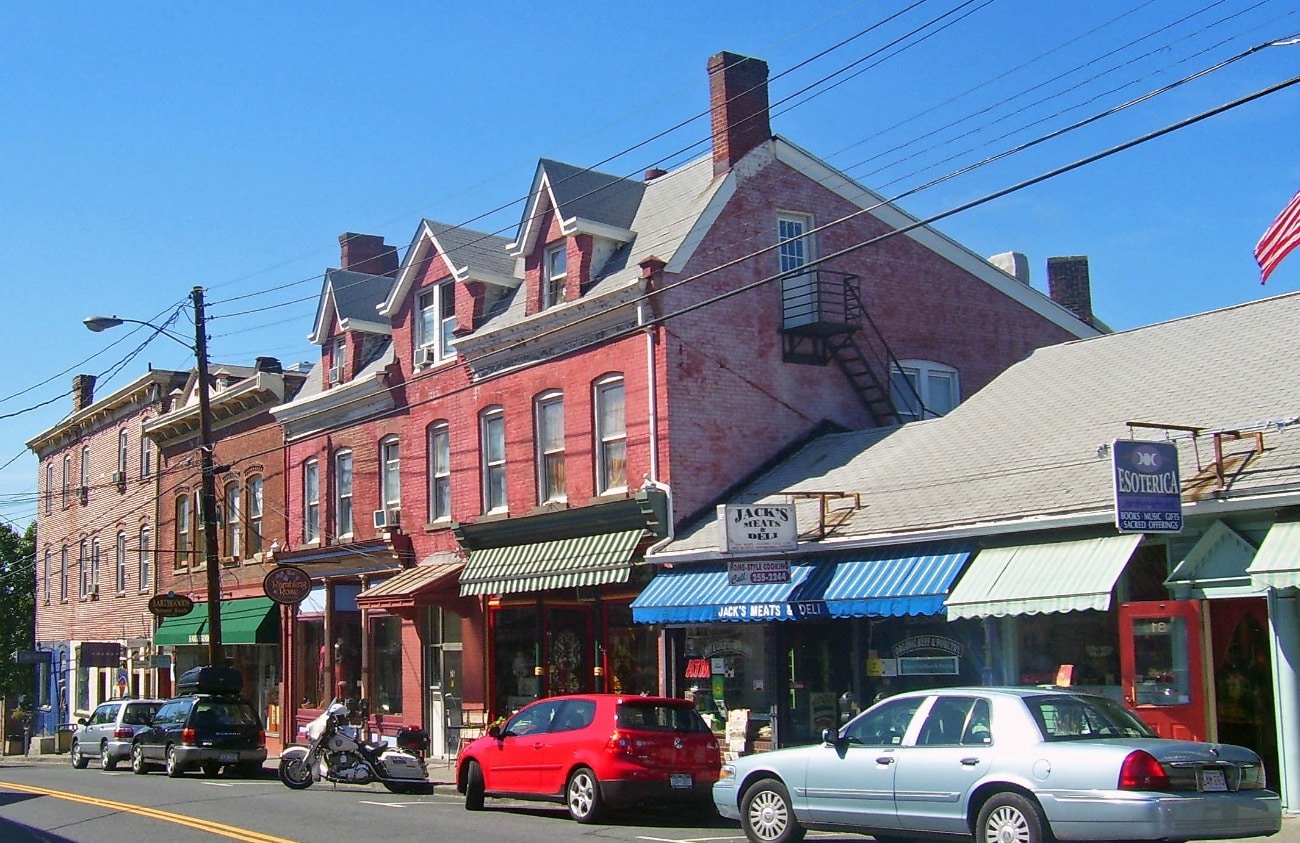The small town of New Paltz, founded in New York’s Hudson Valley in 1678, is home to historic Huguenot Street. It’s also the site of the State University – New Paltz campus and has an astounding number of international restaurants. Steeped in the lore and legend that attends a place whose DNA pre-dates the Revolutionary War, anyone visiting New Paltz will be inspired to connect the dots of American history from its inception to the present day.
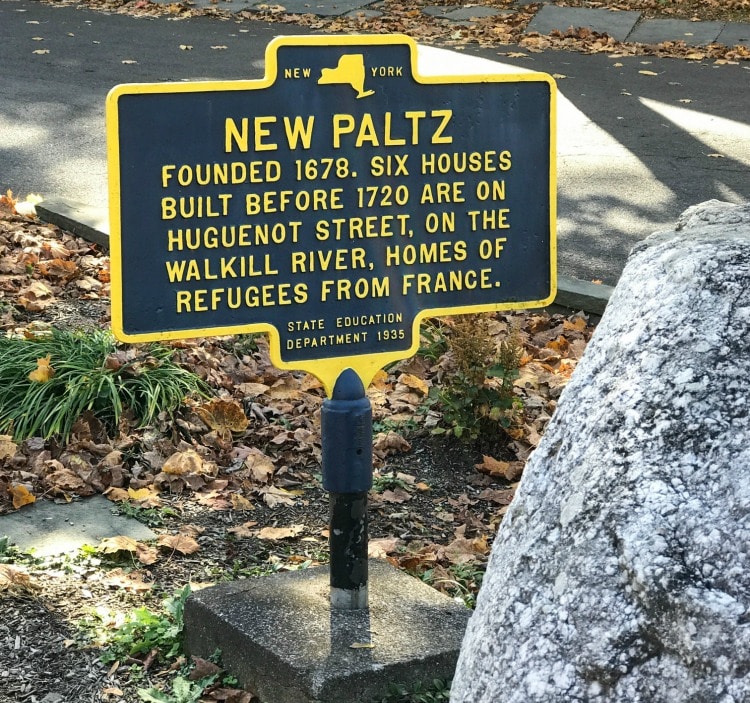
The Huguenots Arrive
Much of the land in this valley was home to the Esopus Munsee Indian tribe for thousands of years when the Huguenots arrived in the 17th century. French Protestants who were fleeing religious persecution, most of them were educated so they were welcomed. But according to the Huguenot Street Organization, when a group of 12 of them purchased a patent for 40,000 acres of land, they were essentially evicting the Indians. It’s doubtful the natives realized the consequences, and, in the end, they were permitted only to hunt and fish on their land. As a result, many chose to leave and migrated west as far as Wisconsin or north into Ontario, Canada. Not long ago, during an annual archeological dig, explorers found the skeleton of a dog dating back to the 1400s with several offerings accompanying it. It was common knowledge that the indigenous people treated their dogs as family members, even leaving small children alone with them believing they’d be protected.
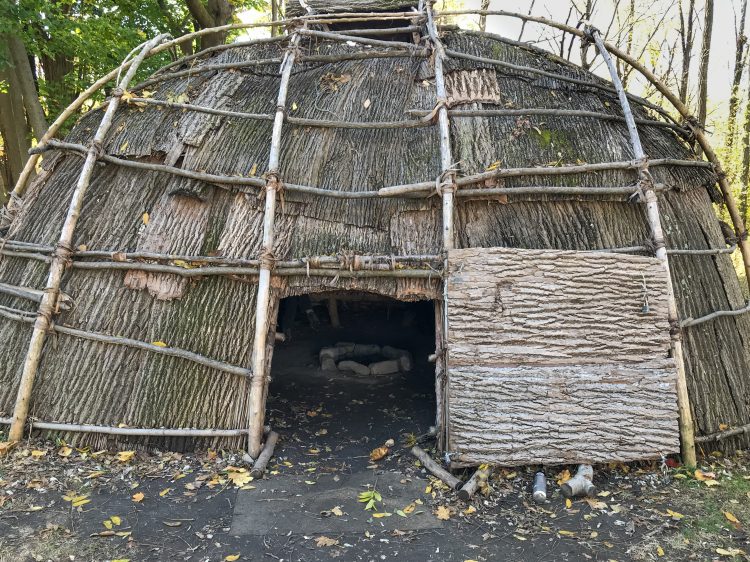
Stepping outside the DuBois Fort Visitor Center on a guided tour, we faced an open field, the spot where the excavators found the buried dog. On the fringe was a replica of a wigwam, a dome-shaped shelter consisting of a frame of bent poles covered with pieces of bark, mats or skins. Not entirely unlike a Wild West movie, groups of up to 10 lived comfortably in one of these. In the middle of a dirt floor was a fire pit, used for cooking and warmth, the heat escaping through a small opening at the top. The entrance was quite low; I had to crouch to enter. Our guide said the original opening was even lower to keep heat inside and keep out unwanted visitors and large animals. Narrow benches made from thick tree branches lined three inside “walls” which served for both seating and sleeping. Not exactly deluxe accommodations you might say, but blankets were made from soft deerskin and fox pelts.
National Historic Landmark District
Our one-hour tour along historic Huguenot Street covered a lot of territory. I would have enjoyed spending a little more time as there were some fascinating historical landmarks to see like the seven Huguenot Stone houses built before 1720, a reconstructed 1717 French Church and the Huguenot community’s original burying ground.
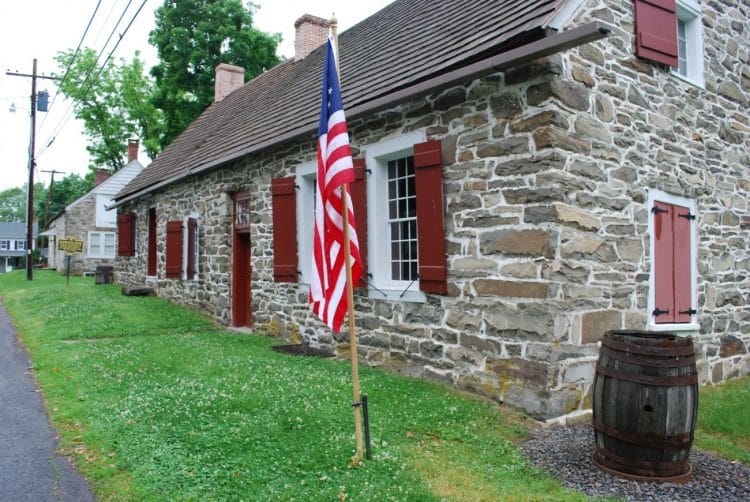
The Abraham Hasbrouck House
This large stone house belongs to Abraham Hasbrouck, who arrived in the early 1670s. The entrance opens on a room used as living/bedroom featuring a richly decorated canopy bed in a corner, a table in the center set with period china, and a kast, a cabinet to store blankets and linens. A remarkable treasure is a jambless fireplace with neither sides nor mantel which was used not only for heating the room but also for cooking. A few steps up lead to another living/bedroom containing two beds, a sofa, and some furnishings.
Our guide led us down a narrow staircase to the slave quarters in the cellar where they lived and cooked three meals a day for the extended family. It had white-washed walls, a wooden floor and three windows, two small and one large. Our guide then explained that originally the quarters had neither white-washed walls nor a wooden floor but a dirt one on which the slaves slept. Also, the large window was non-existent; only the two small ones let in the little bit of light.
Objects of daily use covered a small table in a second room along with the tight-fitting heavy metal collar the slaves were forced to wear. Each one had an identity tag in front etched with the name of the slave’s owner which could be opened only with a special key. It was all so depressing we were glad when we made our way back upstairs.
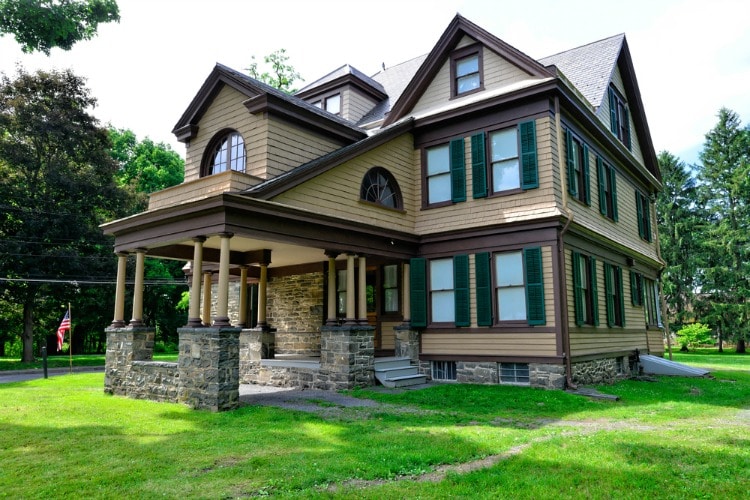
The Deyo House
Around 1894, a skull was unearthed on the grounds of the Deyo House, when a Huguenot descendant was renovating it. With no identification possible, it was stored at the Huguenot Historical Society. Fast forward to the present. When forensic investigation finally advanced to DNA identification, the skull was submitted. Lo and behold it was a male, traced to Africa which indicated he had been one of the family’s slaves. According to Susan Stessin-Cohn, one-time Director of Education at Historic Huguenot Street, from the end of the 17th to the beginning of the 19th century every family on the street owned slaves. Only when New York State outlawed slavery in 1827 did people free them. What was hardest for me to comprehend here is how the persecuted Huguenots could have been slave owners.
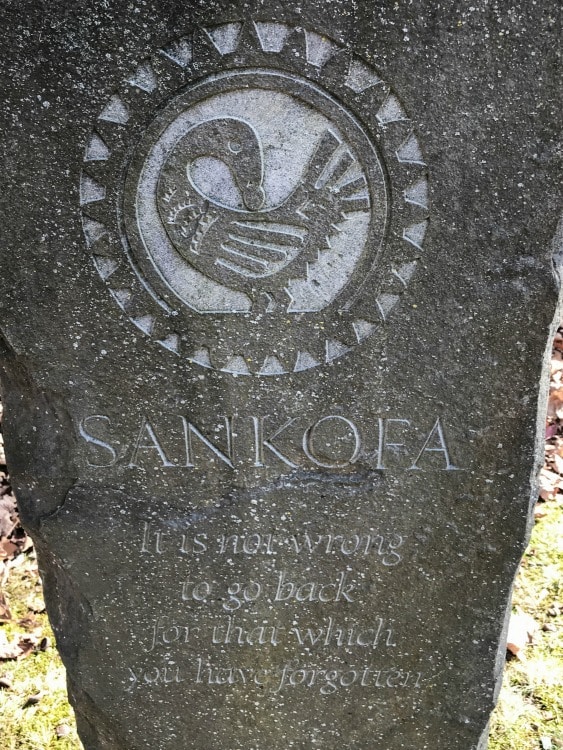
Crispell Memorial French Church
The Crispell Memorial French Church is a 1972 reconstruction of the 1717 stone church used for worship and education. A “burial ground” in front contains the remains of the early Huguenot settlers in the community. In 2013 the Historical Society decided to make symbolic restitution and give the unnamed slave an honorary burial. So, on the grounds where only Caucasians had been interred, they deposited a handcrafted wooden box with the skull amid prayers in Bantu, Kiswahili, and English and tunes from the period played on the fiddle. Then a beautiful headstone was installed depicting a Sankofa, a metaphorical symbol used by the Akan people of West Africa, depicting a bird with its head turned backward, taking an egg from its back. The meaning behind it is that we should reach back and gather the best of our past so that we can achieve full potential in our future. So, in the end, a dismal story had a happy ending.
After our immersion into the multi-layered past of the National Historic Landmark District, we opted for a change of scenery.
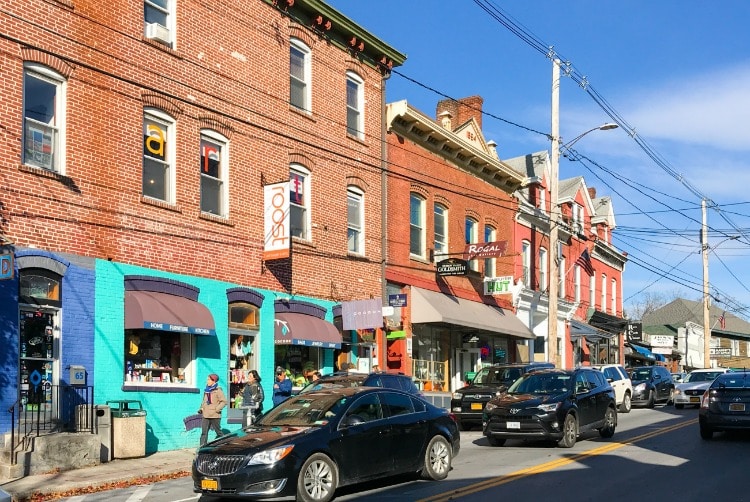
Downtown New Paltz
In the compact village of New Paltz, downtown Main Street is the place to taste diverse international cuisines. You could easily eat your way around the world: French, Italian, Turkish, Thai, Indian, Japanese, Mexican, the list goes on. I wanted something exotic, so we chose the Turkish restaurant Anatolia. The friendly service more than made up for the simple and spare decor. We ordered a tender roasted cubed lamb, deliciously seasoned, rolled in a large pita and served with greens, tomatoes and onions drizzled with a piquant dressing.
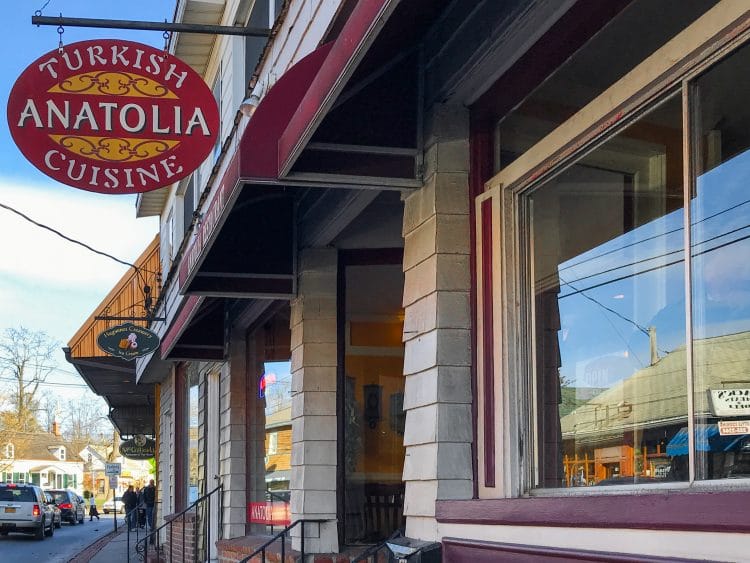
Another find was Garvan’s, built in 1759, a gastropub with an eclectic menu of Irish and British inspired dishes, such as Shepherd’s Pie and Bangers and Mash. The Guinness Lamb Stew with a finger-licking broth was a treat.
SUNY, State University New York – New Paltz
I hadn’t expected such a large, modern campus situated only a few blocks away from historic Main St. Don’t miss the Samuel Dorsky Museum of Art where the temporary exhibitions change frequently. On view is everything from Hudson Valley artists to Japanese Woodblock Prints from the Ukiyo-e Movement.
A must-see is the stunning Campus Commons building at 1 Hawk Drive. The glass structure, which is reminiscent of the Louvre Pyramid, was inspired by the unique landscape of the Catskill Mountains. It was created to provide a grand living room for the University, increase its meeting and presentation space, add a game and recreation center and expand its food court.
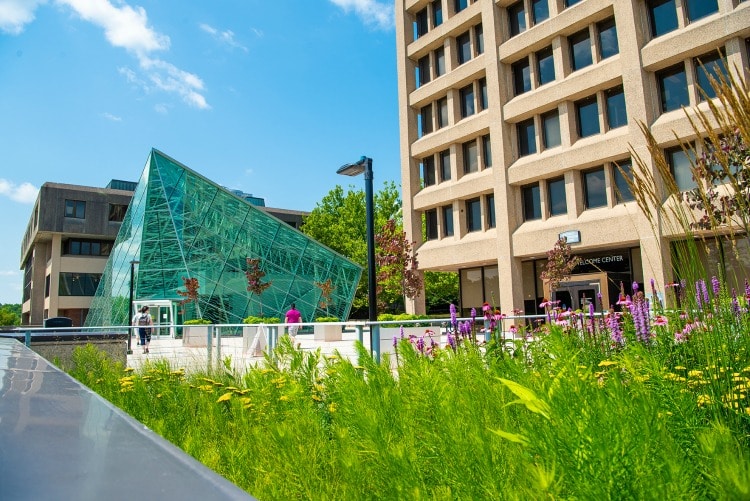
New Paltz surprised me. While on the surface it seems locked in time, its cultural footprint is definitely living in the present day.
[alert type=white]
Where to Eat:
Anatolia – 76 Main St., New Paltz;845-255-1424; www.anatolianp.com
Garvan’s – 215 Huguenot St. (next to a golf course),New Paltz; 845-255-7888; www.garvans.com
What to See & Do:
Huguenot Street Tours – Tour availability and times change, so check before you go. www.huguenotstreet.org
Samuel Dorsky Museum – Check for hours and exhibits; www.newpaltz.edu/museum
[/alert]

